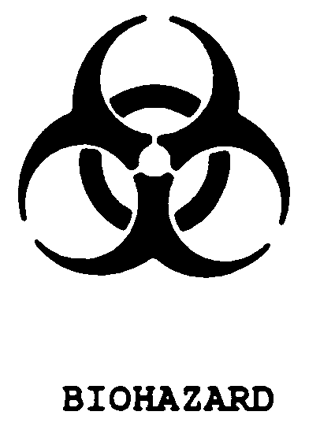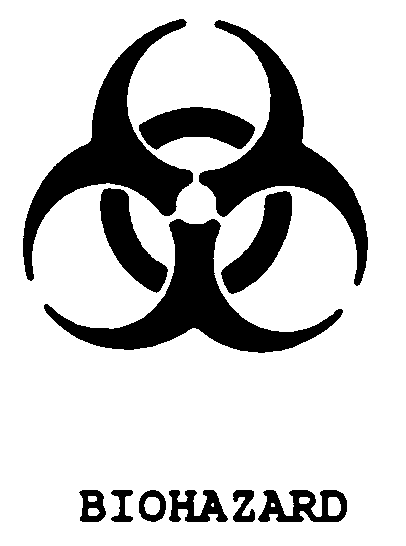Here are some small tasks to keep on top of year-round, to help keep your team members safe every day and focus more of your attention on the most critical safety regulations.
Biohazard and Sharps Containers:
Make sure your Biohazard and Sharps Containers are easily accessible to all employees. Do a quick inspection of your Biohazard Container periodically, depending on how often it is used. The container should be closable, able to contain all biohazardous waste, and leak-proof during storage, handling, and transport (OSHA, 1993). Check to make sure your container has the following label on it.
Approved labels will be “fluorescent orange or orange-red or predominantly so, with lettering and symbols in a contrasting color”, and should be affixed to the container to prevent unintentional removal. If you do not have access to a container with this label, red waste bags and/or containers can be substituted for labeled containers (OSHA, 1993). Biohazard disposal should be in accordance with federal, state, or local regulations.
You can find Biohazard bags, containers, and labels on our website here.
Sharps containers should be placed as close as possible to the general area where sharps are used or anticipated to be found. As with your Biohazard Containers, your Sharps Containers should be inspected periodically depending on usage, and not allowed to overfill (OSHA, 1993). Containers should be closable, resistant to punctures during storage, handling, and transport, leak-proof on the sides and bottom, and appropriately labeled and/or color-coded.
Gloves:
Schedule a monthly check of your inventory to make sure you have gloves available in all the sizes your team needs. Powder free gloves are less messy and reduce the risk of contamination because they don’t leave residue on clothing or hands. Hypoallergenic nitrile gloves should be available for employees that have sensitivities to Latex (OSHA 2011a).
Powder-free Latex and Nitrile Gloves are available on our website here.
Lab Equipment Safety:
When operating an autoclave or other sterilizer, it is important to be conscientious of your risk for burns or cuts when handling heat-sterilized glassware, sharp instruments, or other items (OSHA, 2011b). Be sure to use oven mitts transporting items in and out of the autoclave and steel mesh gloves for handling sharp instruments. Make sure the autoclave door is securely shut and locked before starting a new sterilization cycle. Remember to use autoclave tape to ensure your autoclave is heating to the correct temperature for sterilization (OSHA 2011b).
Centrifuges can cause serious injuries if not operated properly. Be sure to familiarize yourself with the manufacturer’s operating instructions for your specific make and model and follow these instructions every time you operate the centrifuge. Do not over-fill tubes or other containers to avoid contaminating your rotor with your samples (OSHA, 2011c). Always remember to properly balance your rotor and to close the centrifuge lid before operation. Wait until the rotor has come to a complete stop before opening the lid. Employees centrifuging infectious samples should wait 10 minutes after the rotor stops to open the centrifuge lid to allow any possible sample leakage or dangerous aerosols to settle (OSHA, 2011c).
Emergency Procedures:
Have an emergency plan in place and make sure all employees are trained and able to execute it. Be sure you know where the nearest fire extinguisher, fire alarm, and emergency exits are. You should also know where the first aid kits and emergency shower and eyewash stations are in case of an emergency (OSHA, 1993).
Keep yourself and your colleagues safe by keeping on top of these simple safety checks!
Literature Cited
Occupational Safety & Health Administration [OSHA]. (1993). Most Frequently Asked Questions Concerning the Bloodborne Pathogens Standard 1910.1030. Retrieved from https://www.osha.gov/pls/oshaweb/owadisp.show_document?p_table=INTERPRETATIONS&p_id=21010#waste
Occupational Safety & Health Administration [OSHA]. (2011a). Laboratory Safety Guidance. Retrieved from https://www.osha.gov/Publications/laboratory/OSHA3404laboratory-safety-guidance.pdf
Occupational Safety & Health Administration [OSHA]. (2011b). OSHA QUICKFACTS Laboratory Safety – Autoclaves/Sterilizers. Retrieved from https://www.osha.gov/Publications/laboratory/OSHAquickfacts-lab-safety-autoclaves-sterilizers.pdf.
Occupational Safety & Health Administration [OSHA]. (2011c). OSHA QUICKFACTS Laboratory Safety – Centrifuges. Retrieved from https://www.osha.gov/Publications/laboratory/OSHAquickfacts-lab-safety-centrifuges.pdf 2



